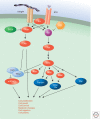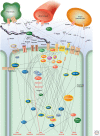Signal transduction in cancer
- PMID: 25833940
- PMCID: PMC4382731
- DOI: 10.1101/cshperspect.a006098
Signal transduction in cancer
Abstract
Cancer is driven by genetic and epigenetic alterations that allow cells to overproliferate and escape mechanisms that normally control their survival and migration. Many of these alterations map to signaling pathways that control cell growth and division, cell death, cell fate, and cell motility, and can be placed in the context of distortions of wider signaling networks that fuel cancer progression, such as changes in the tumor microenvironment, angiogenesis, and inflammation. Mutations that convert cellular proto-oncogenes to oncogenes can cause hyperactivation of these signaling pathways, whereas inactivation of tumor suppressors eliminates critical negative regulators of signaling. An examination of the PI3K-Akt and Ras-ERK pathways illustrates how such alterations dysregulate signaling in cancer and produce many of the characteristic features of tumor cells.
Copyright © 2015 Cold Spring Harbor Laboratory Press; all rights reserved.
Figures






References
-
- Bakan I, Laplante M 2012. Connecting mTORC1 signaling to SREBP-1 activation. Curr Opin Lipidol 23: 226–234. - PubMed
-
- Barthel A, Okino ST, Liao J, Nakatani K, Li J, Whitlock JP Jr., Roth RA 1999. Regulation of GLUT1 gene transcription by the serine/threonine kinase Akt1. J Biol Chem 274: 20281–20286. - PubMed
Publication types
MeSH terms
Substances
LinkOut - more resources
Full Text Sources
Other Literature Sources
Miscellaneous
